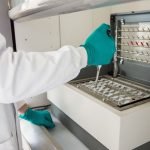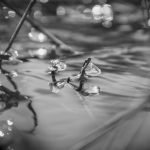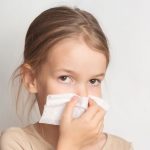Botanicals & Atopic Dermatitis: A Double-Blind, Randomized, Controlled Clinical Trial
Vis Medicatrix Naturae
Michael Traub, ND, DHANP, FABNO
Atopic dermatitis (AD) is a common chronic inflammatory skin disease with a lifetime prevalence of 10-20% in children and 1-3% in adults.1 AD usually starts in early infancy and is characterized by pruritus, erythematous papulovesicular lesions, xerosis (dry skin), and lichenification of the skin.2 In severe cases, intense pruritus and scratching may lead to secondary infection.1 AD is commonly associated with other atopic diseases, such as asthma and seasonal rhinitis.
Without an understanding of the complex and multifactorial pathogenesis of AD, treatment can be difficult and often unsatisfactory. When the structural integrity of the skin is compromised by defects in the keratin filaments supporting the skin barrier, or by mutations, pathogens or allergens, various acquired stressors are able to pass through the hyperpermeable barrier and create chronic inflammation, which in turn further impairs the barrier.3-5
Currently, there is no cure for AD. Management focuses on controlling the severity and duration of symptoms. In mild-to-moderate cases, treatment includes reduction of exposure to triggering factors and topical application of emollients and barrier creams, as well as topical corticosteroids. In more severe cases, the condition is often treated with systemic corticosteroids and other immunosuppressive agents, such as , cyclosporine, and azathioprine. Due to their potential side effects, these treatments are not recommended for long-term use, especially in young children.6-11
An Alternative Approach
One effective topical treatment option is a non-steroidal botanical cream which is formulated to relieve the symptoms of various dermatoses such as atopic dermatitis, contact dermatitis, nummular dermatitis, hand dermatitis, radiation dermatitis, and burns. This emulsion acts by adhering to the injured tissue, eliminating exogenous and contaminated factors related to dermatitis, protecting the skin from further irritation, and maintaining hydration.
The cream consists of 6 botanical extracts: Rheum palmatum, Sanguisorba officinalis, Ailanthus altissima, Scutellaria baicalensis, Cnidium monnieri, and Glycyrrhiza glabra. These botanicals have demonstrated significant anti-inflammatory and anti-allergic activities in experimental studies designed to assist in the relief of AD symptoms.12-13
Clinical Trial
A clinical trial was conducted in 2018 to validate the effectiveness of a combination of the botanicals and homeopathic Sulfur (12X) for the treatment of AD. In order to meet this goal, a vehicle (control) was developed to be verified in comparison with the tested product.
The primary endpoints analyzed were the Investigator Global Assessment (IGA) scale and the Body Surface Area (BSA) for AD. The IGA score is based on the severity of erythema, infiltration, population (ie, number of lesions), and oozing, and is scored by an overall appearance of AD lesions at a given time point. The involved surface area that comprises the total BSA in AD is a crucial factor in grading the degree of severity. The BSA is presented as a percentage index for eczematous lesions and locations.14
Methods
The study was designed as an interventional, multi-center, double-blind, randomized, controlled study. Investigators included 5 board-certified dermatologists and 1 naturopathic physician (the author).
Subjects were randomly divided into 3 treatment groups: tested product (which contained the vehicle), vehicle alone, and comparator. The vehicle included all ingredients in the same percentages as in the tested product (including Sulfur 12X) but without the 6 botanicals, whereas the comparator was a leading over-the-counter brand for eczema in the US market. All 3 groups used the same proprietary wash for the body and face, followed by 1 of the 3 treatment creams, which was applied to the affected areas on the face and body twice daily for 28 days.
One hundred and eight (108) subjects with uncomplicated, stable, mild-to-moderate atopic dermatitis were recruited and qualified for the study: 71 females and 37 males, ages 3 to 73 years old.
The investigators assessed the severity of their respective subjects using the Investigator Global Assessment (IGA) and affected Body Surface Area (BSA) at each of the visit days (days 0, 7, 14, and 28).
Results & Conclusion
The tested product demonstrated an improvement in IGA and BSA over the vehicle at every visit across the treatment period, validating that the botanical product was much more effective and beneficial than the same product without the botanicals (p=0.0369 for BSA). The tested product and the comparator reached exactly the same percentage (34%) of “clear” IGA subjects out of the total enrolled subjects, presenting a clear advantage over the vehicle.
The results demonstrated that the botanical combination was the key factor responsible for the efficacy and improvement of the AD symptoms within this study population. We now have a clinically validated product to manage atopic dermatitis in both children and adults.
The author will be giving a presentation on “Humor, Happiness, Kissing and Sex in Dermatology” at the 2019 Integrative Dermatology Symposium, October 3-5, in San Diego, CA. (For information, visit https://integrativedermatologysymposium.com/)
Disclaimers: The trial was funded by Kamedis, Inc. The author was paid by Kamedis to conduct this research, and he also serves on their Medical Advisory Board. Otherwise, he has no financial ties to the company.
References:
- Leung DY, Boguniewicz M, Howell MD, et al. New insights into atopic dermatitis. J Clin Invest. 2004;113(5):651-657.
- Yao TC, Ou LS, Yeh KW, et al. Associations of age, gender, and BMI with prevalence of allergic diseases in children: PATCH study. J Asthma. 2011;48(5):503-510.
- Brook I, Frazier EH, Yeager JK. Microbiology of infected atopic dermatitis. Int J Dermatol. 1996;35(11):791-793.
- Elias PM, Schmuth M. Abnormal skin barrier in the etiopathogenesis of atopic dermatitis. Curr Opin Allergy Clin Immunol. 2009;9(5):437-446.
- Palmer CN, Irvine AD, Terron-Kwiatkowski A, et al. Common loss-of-function variants of the epidermal barrier protein filaggrin are a major predisposing factor for atopic dermatitis. Nat Genet. 2006;38(4):441-446.
- Bjorksten B, Sepp E, Julge K, et al. Allergy development and the intestinal microflora during the first year of life. J Allergy Clin Immunol. 2001;108(4):516-520.
- Faergemann J. Atopic dermatitis and fungi. Clin Microbiol Rev. 2002;15(4):545-563.
- Saurat JH, Hanifin JM. Understanding atopic dermatitis: pathophysiology and etiology. Conclusion. J Am Acad Dermatol. 2001;45(1 Suppl):S67-S68.
- Nomura I, Goleva E, Howell MD, et al. Cytokine milieu of atopic dermatitis, as compared to psoriasis, skin prevents induction of innate immune response genes. J Immunol. 2003;171(6):3262-3269.
- Ong PY, Ohtake T, Brandt C, et al. Endogenous antimicrobial peptides and skin infections in atopic dermatitis. N Engl J Med. 2003;347(15):1151-1160.
- Sawamura D, Goto M, Shibaki A, et al. Beta defensin-3 engineered epidermis shows highly protective effect for bacterial infection. Gene Ther. 2005;12(10):857-861.
- Nebus J, Nystrand G, Fowler J, Wallo W. A daily oat-based skin care regimen for atopic skin. J Am Acad Dermatol. 2009;60(3):AB67.
- Saeedi M, Morteza-Semnani K, Ghoreishi MR. The treatment of atopic dermatitis with licorice gel. J Dermatolog Treat. 2003;14(3):153-157.
- Reuter J, Wölfle U, Weckesser S, Schempp C. Which plant for which skin disease? Part 1: Atopic dermatitis, psoriasis, acne, condyloma and herpes simplex. J Dtsch Dermatol Ges. 2010;8(10):788-796.
 Michael Traub, ND, DHANP, FABNO, is the medical director of Lokahi Health Center, an integrative clinic in Kailua Kona, Hawaii. His father was a dermatologist, and Dr Traub was inspired to undertake extra study in this subject and become the leading expert in dermatology in the naturopathic profession. He has taught dermatology at 5 of the 7 accredited naturopathic medical schools in North America, and is the author of Essentials of Dermatologic Diagnosis and Integrative Therapeutics. Dr Traub is past-president of the American Association of Naturopathic Physicians (AANP), and was recognized as “Physician of the Year” by the AANP in 2006.
Michael Traub, ND, DHANP, FABNO, is the medical director of Lokahi Health Center, an integrative clinic in Kailua Kona, Hawaii. His father was a dermatologist, and Dr Traub was inspired to undertake extra study in this subject and become the leading expert in dermatology in the naturopathic profession. He has taught dermatology at 5 of the 7 accredited naturopathic medical schools in North America, and is the author of Essentials of Dermatologic Diagnosis and Integrative Therapeutics. Dr Traub is past-president of the American Association of Naturopathic Physicians (AANP), and was recognized as “Physician of the Year” by the AANP in 2006.










